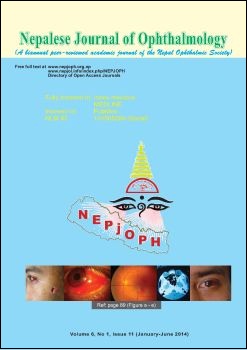Prevalence, risk factors and awareness of diabetic retinopathy among admitted diabetic patients at a tertiary level hospital in Kathmandu
DOI:
https://doi.org/10.3126/nepjoph.v6i1.10760Keywords:
Awareness, diabetic retinopathy, prevalence, risk factorsAbstract
Introduction: Diabetic retinopathy (DR) is one of the commonest causes of visual impairment and blindness in Nepal.
Objectives: The study aims to explore the prevalence, risk factors and awareness of DR among admitted diabetic patients.
Materials and methods: A non-interventional case series study was conducted among the inpatient diabetic cases referred for ophthalmic consultation. The patients’ detailed demographics, awareness on DR, concurrent systemic problems, and glycemic control status were recorded. DR was graded using the Early Treatment Diabetic Retinopathy Study Criteria.
Main outcome measures: The prevalence, risk factors and awareness of diabetic retinopathy among the study participants was analyzed.
Results: A total of 277 diabetic patients were enrolled in the study. The mean age was 62.25 ± 13.26 years. Only one-third (34.6 %) of the cases were admitted for sugar control and newly diagnosed cases comprised of 19.49 %. Nearly half of the cases (46.6 %) were not aware of diabetic retinopathy and dilated fundus evaluation was done for the first time in 44.4 %. DR was found in 38.26 % of the cases and was diagnosed in 13 % of the new cases. Almost four-fifths (78 %) of the diabetics had had the disease for a duration of 16 to 20 years. Clinically significant macular edema was found in 5.78 % and proliferative DR in 2.52 %. DR was significantly associated with the duration of diabetes (P value = 0.001) and concurrent hypertension (P value = 0.004).
Conclusion: The prevalence of DR was 38 % among the admitted diabetic cases and the DR was significantly associated with the duration of diabetes and systemic hypertension. Almost half of the cases had been unaware of DR before referral. This emphasizes the importance of the collaboration of the physician and the ophthalmologist for an early DR detection.
DOI: http://dx.doi.org/10.3126/nepjoph.v6i1.10760
Nepal J Ophthalmol 2014; 6 (2): 24-30
Downloads
Downloads
Published
How to Cite
Issue
Section
License
This license enables reusers to copy and distribute the material in any medium or format in unadapted form only, for noncommercial purposes only, and only so long as attribution is given to the creator.




